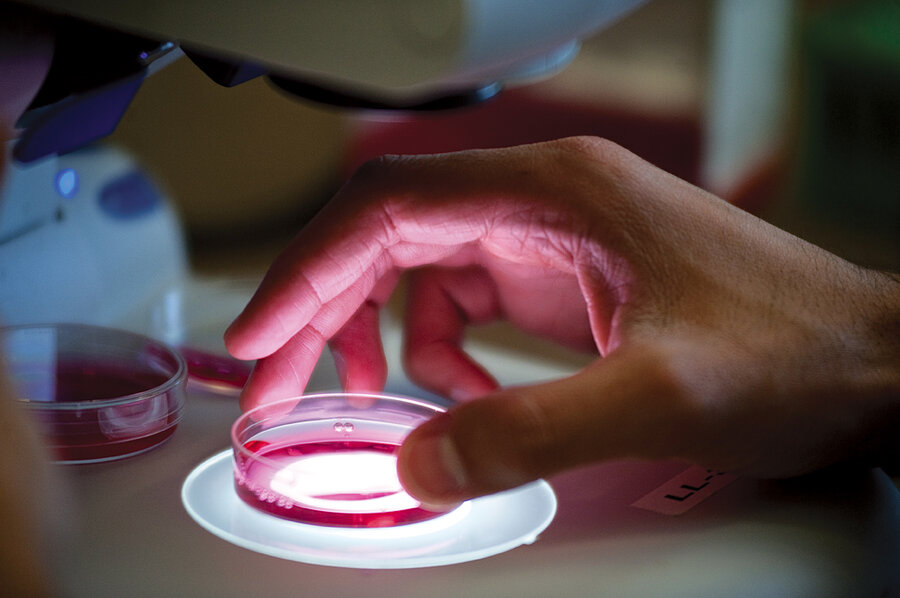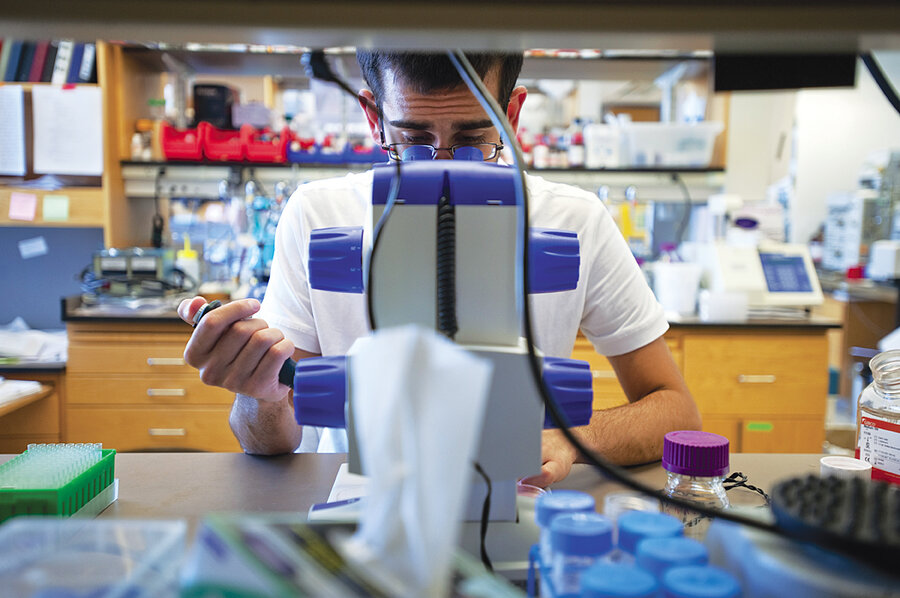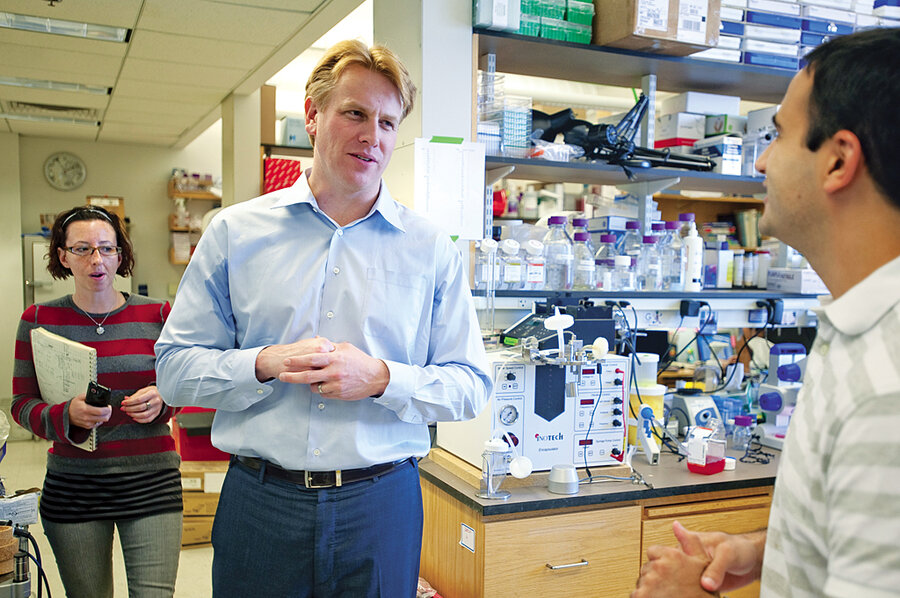Stem cell exodus?
When a judge froze all federal funding for research with human embryonic stem cells on Aug. 23, Jason Spence had no time to lose. Dependent on federal funding for his project to create replacement liver and other cells for patients, the stem-cell researcher had nine days before his project – and salary – expired.
Dr. Spence and the director of his lab at Cincinnati Children's Hospital began calling everyone they could think of, from hospital administrators to private agencies. After his funding officially lapsed on Sept. 1, the executive director of another institute at the hospital stepped in with temporary funds. Spence's project was safe, for the moment.
Then on Sept. 9, a federal appeals court temporarily stayed the injunction, allowing federal research money to flow once again to Spence and 21 other scientists whose funding had already stopped. On Sept. 28, they ruled that funding will continue, pending the outcome of an ongoing lawsuit. The appeals court has expedited the trial, so funding will be in jeopardy again, soon.
This month-long saga illustrates America's ongoing struggle with human embryonic stem-cell (hESC) research. Supporters say hESC research offers the potential to solve so-called "incurable diseases." Detractors point out that it involves the destruction of human embryos that, in other circumstances, could grow into people. With all the moral objections swirling around it, and the stop-and-go funding it has endured, is hESC research worth pursuing?
That's what many researchers are asking themselves – and their answer could have profound economic implications for the United States.
For all the national angst it generates, hESC research remains a surprisingly small part of stem-cell research. Over the past five years, it has received $530 million in federal funding, only about 3.5 percent of total stem-cell dollars.
Where does the rest of the money go? Half of all private funding and 9 of 10 federal dollars go to stem cells culled from adults, bone marrow, umbilical cords, or animals. So federal funding for hESC research could dry up tomorrow and the field of stem-cell research would continue.
Critics say that's what should happen. "Over 80 cures and treatments have been developed using adult stem cells or [umbilical] cord blood cells, and zero using embryonic cells," says Ron Stoddart, director of Nightlight Christian Adoptions, one of the original plaintiffs in the lawsuit. "Overwhelming advances have been made using adult stem cells. Why spend money to destroy embryos when it's not necessary?"
That's not the full story, supporters counter. "Of course adult stem-cell research is ahead," says Richard Hynes of the Massachusetts Institute of Technology (MIT) in Cambridge, who chaired the committee that wrote hESC research guidelines. "Bone marrow stem cells were discovered 50 years ago; hESCs were only discovered in 1998, and they're already [in] clinical trials."
Is US violating a 1996 law?
The immediate cost to science is the interruption of momentum. In August, Judge Royce Lamberth of the US District Court for the District of Columbia unexpectedly granted a preliminary injunction on hESC funding on the grounds that it violated a 1996 budget rider called the Dickey-Wicker Amendment. The amendment prohibits the use of federal funds to destroy embryos. Scientists had gotten around that requirement by using private funds to pay to extract stem cells from the embryo, then using funding from the National Institutes of Health (NIH) for all subsequent research. Judge Lamberth's injunction disallowed that practice.
"Federal grants are the lifeblood of our program," says George Daley, an hESC researcher with a joint appointment at Harvard and Children's Hospital Boston who, by Sept. 1, had to freeze some of the stem-cell cultures he had been working on and transfer others to a privately funded lab. "We can limp along using private funds, but – especially in this economy – those are hard to find."
Federal funding remains in jeopardy. While Tuesday's ruling keeps the funding flowing for now, the trial on the merits of the original case still lies ahead. A funding refreeze seems likely, as Lamberth granted the August injunction because, he wrote, there was a "strong likelihood" that he would eventually rule that the NIH was violating the Dickey-Wicker Amendment by funding hESC research.
The advantage of hESCs is that they can become any other type of cell. Scientists discovered that some adult cells can be "reprogrammed" to mimic that ability. These cells, known as induced pluripotent stem cells (iPSCs), present new possibilities.
"We all hope that someday [iPSCs] will be viable replacements for embryonic stem cells," says research professor Daniel Anderson, walking between his laboratories, which are scattered across several floors in interconnected buildings at MIT. "But it's not today."
For example: The viruses used to reprogram adult skin cells to act like embryonic stem cells make them unsafe, so far, for many applications. To improve iPSCs, scientists are studying them in parallel with hESCs, learning as much as they can about both.
"The gold standard is still hESC," says Carol Ware, who directs the Tom and Sue Ellison Stem Cell Core at the University of Washington. If hESC research disappears, "you've lost your control group," the base line against which to compare the iPSC work.
Some stem-cell researchers move abroad
Some scientists warn that US constraints on hESC research could push scientists to move their research overseas. "This research will go on whether or not we play the game," says Randall Moon, who directs the Institute for Stem Cell and Regenerative Medicine at the University of Washington. "The hope is that the US will come to its senses in time to take the lead rather than pick up the pieces."
When George W. Bush first constricted federal dollars for the research in 2001, a few scientists headed for labs in Singapore and Britain. But they tended to be nationals of those countries. Most American scientists are reluctant to defect abroad.
More are willing to move west to benefit from the California Institute for Regenerative Medicine, which is spending $3 billion over 10 years on stem-cell research. CIRM has distributed more than $1 billion already; 56 percent of it has gone to hESC research. New York, Maryland, and nine other states have collectively pledged $1.1 billion over 10 years to stem-cell research, out of which an indeterminate amount will go to hESC research.
Another nonfederal funding avenue is private research money. Several of the biggest labs already have ties to private organizations like the Howard Hughes Medical Institute and the Juvenile Diabetes Foundation, but those can't replace lost NIH funds.
Pharmaceutical companies aren't interested in funding this work yet, because profitable treatments are still too far in the future. "Your typical pharmaceutical company doesn't want to get involved while it's still this risky," says Dr. Anderson. "The NIH has been able to fund this work without any expectation of profit." A few venture capitalists have expressed interest, but none is yet a "major player," he adds.
Younger scientists and staff may consider moving out of academia and hospitals altogether. Two companies dominate the field: Geron Corp., in California, which is beginning clinical trials for a stem-cell treatment for spinal cord injury, and Advanced Cell Technology, which has labs in California and Massachusetts. Both of these small, publicly traded biotech companies operate at a severe loss as they try to create "biopharmaceuticals" from stem cells.
Costs if research goes private
If research shifts from academia to private industry, it could affect the pace of development, as confidentiality clauses keep major discoveries out of peer-reviewed literature. Some scientists would chafe at the restrictions, but others would value the dependability of funding.
Other young scientists may leave the field entirely. Dr. Daley, the Harvard University-Children's Hospital researcher who had to freeze his cell cultures after his funding froze, worries about "the insidious impact of this kind of ruling on the decisions scientists make – and students – to go into certain fields. You retool your career. "
Spence, freshly re-funded, is so far sticking with his research. Even if there's another reversal, his NIH funding is safe for a year. "It's been a ride, that's for sure," Spence says. "Not a fun ride, but it's been a ride."







